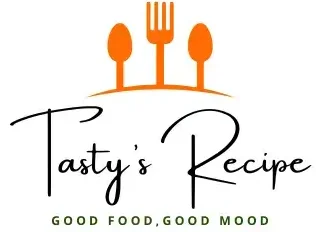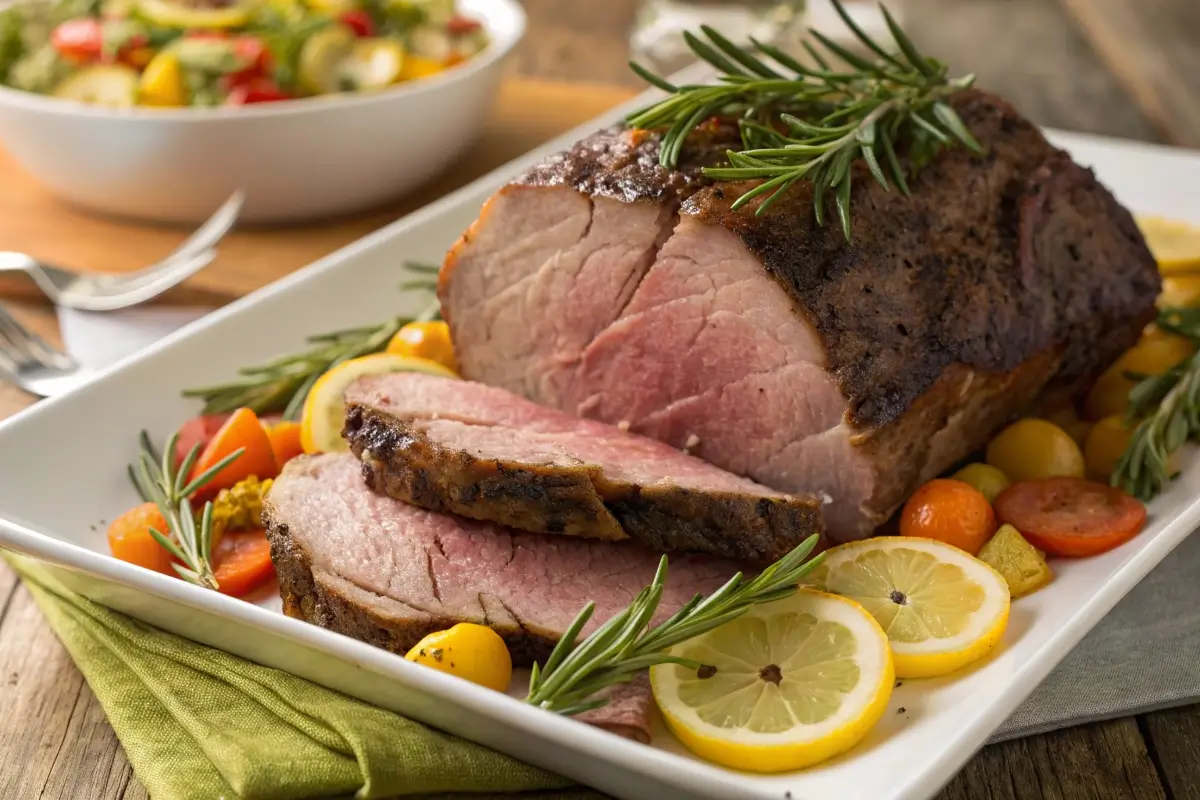When Easter Sunday rolls around, many families gather to celebrate with a meal that’s comforting, hearty, and symbolic. While ham often takes the spotlight, Easter roast beef has been making its way to the center of the table as a delicious and memorable alternative. Whether you’re looking to impress guests with a tender prime rib roast or create a cozy family meal with a seasoned chuck roast, this guide has you covered.
Check out our sweet finale: Easter Egg Cookie Cake – The Ultimate Sweet Centerpiece
It was Easter Sunday, and Grandma’s little farmhouse kitchen was buzzing with warmth and the smell of rosemary and garlic. The family had gathered from near and far, filling every seat at the long oak table. Laughter danced between stories, and children darted under chairs with chocolate-stained fingers.
At the center of it all was the roast beef—thick, juicy, and golden-brown—the crown jewel of the meal. Grandma had been making the same recipe for over 30 years, marinating it the night before, waking early to roast it slow and low.
As dinner wound down, only one perfect slice remained. Everyone hesitated, eyeing it politely, but no one dared to take the last bite.
Until little Emma, no more than six, reached up with her tiny fork and said, “Grandma, can I have the last piece?”
The room fell quiet, then burst into soft laughter.
“Of course, sweetheart,” Grandma smiled, placing it on her plate with a wink. “That’s what it’s there for.”
And in that moment, surrounded by food, family, and spring sunshine, everyone agreed—it wasn’t the roast beef that made Easter special. It was who you shared it with.
Table of Contents
Understanding the Tradition Behind Easter Roast Beef
The History of Easter Meals and Their Significance
Easter is one of the most important holidays on the Christian calendar, celebrating the resurrection of Jesus Christ. For centuries, Easter feasts have held great cultural and religious significance. Traditionally, lamb was considered the symbolic meat of choice, representing sacrifice and rebirth. Over time, however, the types of dishes served on Easter have evolved.
In many Western households, beef has become a delicious and hearty alternative to lamb, especially when cooking for a crowd. The rise of Easter Roast Beef on Sunday can be credited to its rich flavor, the wide availability of different beef cuts, and its ability to serve large groups with ease.
Why Roast Beef Has Become a Popular Easter Option
So why are more people choosing easter roast beef over traditional meats like ham or lamb?
First, it’s a matter of taste. Not everyone enjoys the sweetness of glazed ham or the gamey flavor of lamb. Roast beef offers a rich, savory profile that pairs beautifully with spring vegetables and bold sauces like horseradish cream or red wine reduction.
Choosing the Perfect Cut for Easter Roast Beef

Best Cuts of Beef for Roasting
Choosing the right cut of beef can make or break your Easter roast. When you’re aiming for that mouthwatering, tender centerpiece, you’ll want to select a cut that balances marbling (fat), flavor, and tenderness.
Here are the top cuts to consider for your Easter roast beef:
| Cut | Flavor Profile | Tenderness | Best For |
|---|---|---|---|
| Prime Rib | Rich, beefy, well-marbled | Extremely tender | Show-stopping Easter centerpiece |
| Ribeye Roast | Juicy and flavorful | Very tender | Smaller gatherings |
| Sirloin Tip Roast | Lean and savory | Moderately tender | Budget-friendly family meals |
| Chuck Roast | Deep, beefy flavor | Needs slow-cooking | Comfort food, pot roast style |
| Tenderloin Roast | Mild, super tender | Ultra tender | Elegant, upscale Easter brunch |
If you’re looking to impress, go for a prime rib roast. It’s the king of beef roasts, known for its melt-in-your-mouth texture and show-stopping presentation. It’s pricier, but absolutely worth it for a special holiday like Easter.
Comparing Ribeye, Sirloin, and Chuck for Easter Dinners
Let’s break down some popular roast choices and how they stack up against each other for your Easter feast:
- Ribeye Roast: Offers a balanced fat content and intense beef flavor. It doesn’t need much seasoning—just salt, pepper, and herbs—and it’s best cooked medium-rare to medium. It’s perfect for oven roasting at 325°F until it hits an internal temperature of 135°F.
- Sirloin Roast: Leaner and less expensive, but still full of flavor when cooked low and slow. It benefits from a marinade or rub to tenderize the meat and boost flavor. This roast pairs wonderfully with garlic, rosemary, and a splash of red wine.
- Chuck Roast: This one is best when cooked for several hours at low heat or in a slow cooker. It’s incredibly flavorful due to its connective tissue, which breaks down over time and creates a fork-tender texture. This is your go-to for a homey, comforting Easter dinner.
Don’t miss our dinner idea: Chicken Rosemary Lasagna – The Ultimate Comfort Food Recipe
How to Season and Marinate Easter Roast Beef
Classic Easter Roast Beef Marinade Recipes
To bring out the full potential of your Easter Roast Beef, seasoning is everything. While beef already packs a bold flavor, a well-chosen marinade adds depth, tenderness, and a touch of seasonal charm.
Here are two go-to marinade recipes perfect for Easter:
Herb-Garlic Marinade (Traditional and Elegant)
This marinade is ideal for cuts like prime rib or tenderloin. It brings a fresh, garden-like aroma to your table—perfect for spring.
Ingredients:
- 1/4 cup olive oil
- 4 cloves garlic, minced
- 2 tbsp fresh rosemary, chopped
- 2 tbsp thyme leaves
- 1 tbsp Dijon mustard
- Zest and juice of 1 lemon
- Salt and black pepper to taste
Instructions: Mix all ingredients in a bowl and rub generously over your beef roast. Let it marinate in the fridge for 4–6 hours or overnight for deeper flavor.
Red Wine and Onion Marinade (Rich and Bold)
This marinade works wonders for chuck or sirloin cuts. It’s a great choice if you’re slow-roasting your Easter beef.
Ingredients:
- 1 cup dry red wine
- 1/2 cup beef broth
- 1 onion, thinly sliced
- 3 garlic cloves, smashed
- 2 tbsp Worcestershire sauce
- 1 tsp smoked paprika
- Salt and pepper to taste
Instructions: Combine all ingredients and pour over the roast in a sealed bag or container. Marinate in the refrigerator for at least 6 hours, turning occasionally.
Dry Rubs vs. Wet Marinades: What’s Best for Easter?
So which method should you use—a dry rub or a marinade? It depends on the cut and the experience you want to create.
| Method | Best For | Flavor Impact | Cooking Method |
|---|---|---|---|
| Wet Marinade | Lean or tougher cuts (e.g., sirloin, chuck) | Deep flavor infusion and tenderizing | Slow roast, braising |
| Dry Rub | Well-marbled cuts (e.g., ribeye, prime rib) | Crusty, flavorful bark | Oven roasting, grilling |
Dry rubs are ideal for higher-end cuts that already have good fat content. The rub enhances the natural flavor and helps form a crust during roasting.
Wet marinades are better for leaner cuts, helping to add juiciness and complexity. A combination of acidic and aromatic ingredients can work magic over time.
Cooking Methods for a Juicy Easter Roast Beef
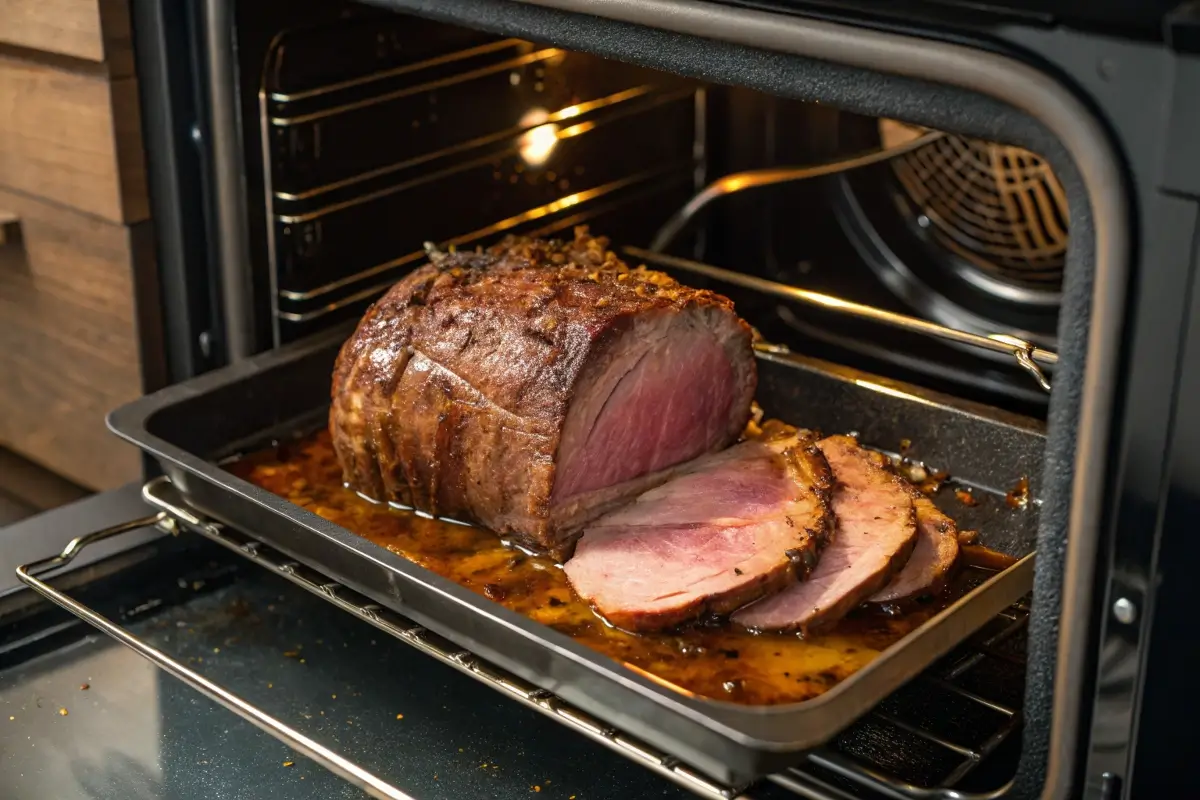
Oven Roasting Techniques for Tender Results
Oven roasting is the classic way to cook an Easter roast beef—and for good reason. It delivers a beautiful crust, a juicy interior, and that irresistible roast aroma that fills the kitchen with anticipation.
Step-by-Step Guide to Oven Roasting:
- Preheat the oven to 450°F (232°C).
- Bring roast to room temperature for 30–60 minutes before cooking.
- Place the roast on a rack in a shallow roasting pan to allow airflow.
- Insert a meat thermometer into the thickest part (away from bones or fat).
- Roast at high heat (450°F) for 15–20 minutes to develop a crust.
- Lower the heat to 325°F (163°C) and roast until your desired internal temperature is reached:
- Rare: 120–125°F
- Medium Rare: 130–135°F
- Medium: 140–145°F
- Rest for 15–20 minutes before slicing to let juices redistribute.
| Weight | Estimated Cook Time at 325°F |
|---|---|
| 3 lbs | 1 hr 15 min – 1 hr 30 min |
| 5 lbs | 1 hr 45 min – 2 hr 15 min |
| 7 lbs | 2 hr 30 min – 3 hr |
Tip: Resting is non-negotiable. Cutting too early will drain all the juices—leaving you with dry beef, no matter how perfectly it was cooked.
Looking for inspiration? Try: Street Corn Chicken Rice Bowl Recipe – A Flavorful Fusion Dish
Slow Cooker and Instant Pot Easter Roast Beef
If your Easter Sunday is packed with family events, church, and egg hunts, slow cookers and Instant Pots are your best friends. They let you “set it and forget it,” leaving more time for guests and celebration.
Slow Cooker Easter Roast Beef
- Sear your beef in a hot skillet to develop flavor before transferring to the cooker.
- Add onions, garlic, carrots, broth, and herbs.
- Cook on low for 8 hours or high for 4–5 hours, until fork-tender.
- Serve with the juices or turn them into a gravy.
Best for: Chuck roast, brisket, or bottom round.
Instant Pot Easter Roast Beef
- Sear your roast using the “Sauté” function.
- Deglaze with wine or broth.
- Add aromatics and pressure cook on High for 60–90 minutes (depending on size).
- Allow natural release for 10–15 minutes.
Best for: Sirloin tip roast or chuck roast.
Want a dessert that balances your savory roast? Discover great ideas like: Kefir Sheet Cake Recipe Card – A Moist and Fluffy Delight
Now that you’ve nailed the cooking method, let’s bring the whole meal together with side dishes that pair perfectly with Easter roast beef.
Easter Side Dishes That Complement Roast Beef
Traditional Sides Like Mashed Potatoes and Carrots
When it comes to building a classic Easter dinner plate, traditional side dishes never fail. They bring warmth, comfort, and balance to the rich flavor of Easter roast beef.
Here are a few favorites that never go out of style:
Garlic Mashed Potatoes
Creamy, buttery mashed potatoes are the perfect counterpart to juicy roast beef. Add roasted garlic for extra depth and finish with a swirl of heavy cream for richness.
Glazed Carrots
Bright and slightly sweet, glazed carrots not only taste great but also add color to your Easter table. Use a brown sugar and honey glaze with a pinch of cinnamon for a spring-inspired twist.
Roasted Asparagus with Lemon Zest
This vibrant green veggie pairs perfectly with beef. Roast at 400°F for 12–15 minutes and finish with lemon zest and sea salt. It’s quick, easy, and refreshing.
Yorkshire Pudding
A traditional British side, Yorkshire pudding is a light, puffed pastry made from beef drippings. It’s perfect for soaking up gravy and adds an elegant flair to your Easter spread.
Creative Easter Side Dish Ideas with a Modern Twist
If you’re looking to elevate your Easter feast beyond the classics, consider adding a few fresh, creative options to wow your guests.
Spring Pea and Mint Salad
This cool, crisp salad is a refreshing contrast to roast beef. Toss fresh peas with arugula, chopped mint, shaved Parmesan, and a lemon vinaigrette.
Scalloped Potatoes with Gruyère
A fancier take on mashed potatoes, this dish layers thinly sliced potatoes with cheese, cream, and herbs. Bake until bubbly and golden.
Balsamic Roasted Brussels Sprouts
Sliced Brussels sprouts tossed in olive oil and balsamic vinegar caramelize beautifully in the oven. Add dried cranberries or chopped pecans for texture and color.
Don’t miss our flavor-packed idea: Mind-Blowing Taco Soup Fritos Recipe That Will Blow Your Mind
Serving Suggestions for Easter Roast Beef
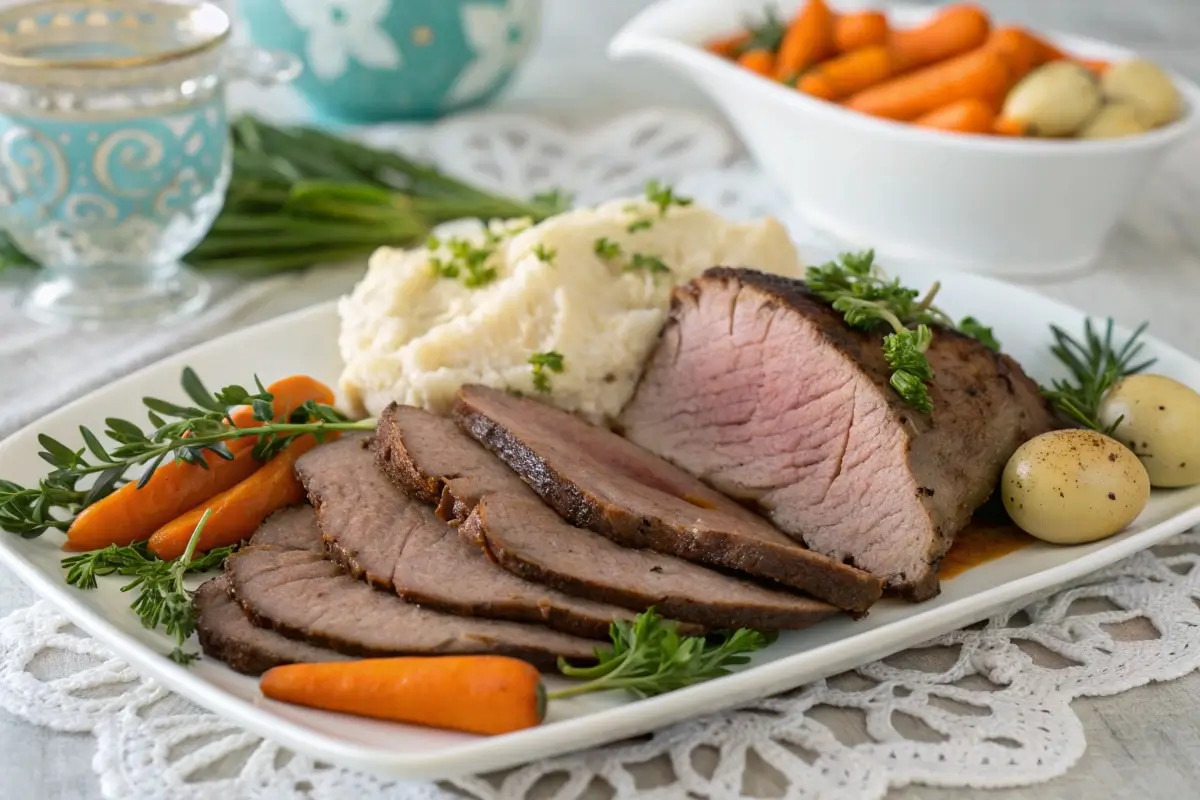
How to Plate Roast Beef Elegantly for Easter Brunch
Presentation matters—especially for a holiday as special as Easter. A well-plated Easter roast beef doesn’t just taste amazing; it creates an experience for your guests and sets the tone for your celebration.
Here are a few simple plating tips that can turn a good meal into a great one:
Slice Before Serving (With Care)
Always slice the roast against the grain to keep it tender. Use a sharp carving knife or an electric slicer to get uniform, clean slices. Thin slices are best for tender cuts like prime rib, while thicker cuts suit chuck roast or sirloin.
Use a White Platter for Contrast
A large, clean white platter makes your roast beef and sides pop. Arrange the beef slices slightly overlapped in the center, fanned out like a half-circle. It adds dimension and makes it easier to serve.
Add Visual Interest with Garnishes
Sprigs of rosemary, thyme, or parsley make excellent garnishes. They add color, fragrance, and a subtle nod to the herbs used in your marinade or seasoning. You can also scatter a few edible flowers (like pansies or violets) for a spring-themed effect.
Drizzle with Pan Juices or Gravy at the Table
Serve gravy or jus on the side or drizzle lightly over the roast just before serving. For that showstopper moment, pour the sauce in front of guests as you serve—it creates aroma and drama at the same time.
Garnishes, Gravies, and Sauces That Elevate the Dish
A roast beef meal is never truly complete without a bold, flavorful sauce. These accompaniments can enhance the flavor of your roast while offering balance to the entire plate.
Red Wine Reduction Sauce
A deeply savory sauce with notes of garlic, shallots, and thyme. Simmer red wine with beef stock and herbs until thickened. Strain and finish with a knob of butter.
Horseradish Cream Sauce
Mix sour cream, prepared horseradish, lemon juice, and chives. It’s tangy and spicy—great for cutting through the richness of roast beef.
Tips for Hosting an Easter Feast Featuring Roast Beef
Easter Table Setup and Décor Ideas
Hosting Easter dinner is more than just cooking—it’s about creating a warm, welcoming atmosphere that makes your guests feel special. With the Easter roast beef as your showpiece, the rest of your table should complement the celebration.
Here’s how to set the stage:
Color Palette Matters
Go for light, springtime hues—think pastel pinks, greens, soft yellows, and lavender. Use a neutral or white tablecloth as a base and add color with napkins, plates, or a floral runner.
Fresh Flowers and Greenery
Place a bouquet of tulips, daffodils, or lilacs in a vase at the center of your table. You can also tuck sprigs of fresh herbs like rosemary or thyme into napkin rings for a fragrant and elegant touch.
Layer Your Place Settings
Stack plates with intentional layering: charger, dinner plate, salad plate. Add a linen napkin tied with twine or ribbon. Place a small chocolate egg or name tag on each plate as a sweet surprise for your guests.
Check out more holiday inspiration here: Easter Egg Cookie Cake – The Ultimate Sweet Centerpiece
Make-Ahead Tips and Cooking Timeline for Easter Day
The secret to a smooth, stress-free Easter feast is all in the planning. With a smart timeline, you’ll spend less time in the kitchen and more time enjoying your guests.
1–2 Days Before Easter:
- Finalize your menu and grocery list
- Prep marinades or dry rubs
- Chop veggies and store them in airtight containers
- Bake desserts or prep dough for dinner rolls
- Set the table if space allows
Easter Morning:
- Remove roast beef from the fridge to bring it to room temp
- Preheat oven and prep your roasting pan
- Place the beef in the oven or slow cooker
- Prepare side dishes—many can be baked together at 350°F
- Chill drinks and garnish with citrus or herbs
1 Hour Before Serving:
- Let roast beef rest before carving
- Finish sauces and gravies
- Reheat or finish off sides if needed
- Plate desserts or garnish with seasonal touches
Just Before Guests Arrive:
- Light candles
- Put on background music (think soft jazz or acoustic classics)
- Do one last sweep of the dining area for clutter or mess
Hosting an Easter feast doesn’t have to be overwhelming. With a solid plan and a touch of creativity, you’ll create a warm and memorable celebration centered around a delicious Easter roast beef.
Leftover Easter Roast Beef Recipes
Creative Ways to Use Leftover Roast Beef After Easter
One of the best parts about serving roast beef for Easter? The leftovers. Done right, yesterday’s meal becomes today’s lunch, dinner—or even breakfast—with very little effort. These leftover recipes are full of flavor, quick to whip up, and far from boring.
1. Roast Beef Sandwiches with Horseradish Mayo
Layer thin slices of roast beef onto a crusty roll with arugula, caramelized onions, and a homemade horseradish mayo. Toast it for extra crunch and melt a slice of Swiss cheese over the top.
2. Beef Hash with Eggs
Dice leftover beef and sauté it with cubed potatoes, onions, and bell peppers. Top with a sunny-side-up egg for a hearty brunch. It’s a one-pan wonder that brings comfort and flavor.
3. Beef and Veggie Stir-Fry
Slice the beef thin and toss it into a hot skillet with soy sauce, garlic, ginger, and your favorite stir-fry veggies. Serve over rice or noodles for a quick weeknight dinner.
4. Roast Beef Quesadillas
Fill tortillas with beef, shredded cheese, sautéed onions, and jalapeños. Grill until golden and serve with salsa or guac. A fusion twist that’s ready in under 15 minutes.
5. Creamy Beef Stroganoff
Use the roast beef in place of stew meat—just warm it gently at the end. Toss with mushrooms, onions, sour cream, and egg noodles for a rich and cozy meal.
Looking for comfort food with a twist? Try this favorite: Chicken Rosemary Lasagna – The Ultimate Comfort Food Recipe
Storing, Freezing, and Reheating Tips
You’ve spent hours preparing the perfect roast—so don’t let any of it go to waste. Here’s how to keep your leftovers fresh and flavorful.
Storing
- Store sliced beef in an airtight container with some of the pan juices to keep it moist.
- Keep in the fridge for up to 4 days.
Freezing
- Wrap slices in foil or plastic wrap, then place in a freezer-safe bag.
- Label with the date and use within 2–3 months for best quality.
Reheating
- Reheat gently in a covered dish with a splash of broth or water at 325°F.
- For microwave, use a low power setting and cover to retain moisture.
Frequently Asked Questions About Easter Roast Beef
What is the traditional Easter roast?
Traditionally, Easter roast refers to roasted lamb, symbolizing sacrifice and rebirth in Christian faith. However, over the years, the tradition has expanded to include a variety of meats depending on cultural preferences and availability. In many modern households, Easter roast beef has become a celebrated centerpiece thanks to its hearty flavor, versatility, and ability to serve a large group. It’s now widely accepted as a festive and satisfying Easter dinner option.
What is the traditional meat for Easter?
In Christian tradition, lamb is the most symbolic and historic Easter meat, especially in European cultures. It represents the “Lamb of God,” or Jesus Christ, whose resurrection is celebrated on Easter Sunday. However, ham is also popular in the United States due to its availability and the timing of spring pork curing. More recently, Easter roast beef has joined the ranks as a modern and delicious Easter meat, especially for those looking for a savory, non-pork alternative.
Can you eat roast beef on Easter Sunday?
Absolutely, yes. There are no religious or cultural restrictions against enjoying Easter roast beef on Easter Sunday. In fact, more and more families are choosing it as their go-to holiday meat due to its richness, ease of preparation, and the variety of cuts available. Whether slow-roasted or cooked in an Instant Pot, roast beef makes for an impressive and satisfying Easter main course.
What kind of roast to make for Easter?
The best type of roast for Easter depends on your preferences and guest list size. Here are some top choices:
- Prime Rib: Luxurious and flavorful, perfect for large gatherings.
- Tenderloin: Lean, tender, and elegant for formal Easter brunches.
- Ribeye Roast: Rich and well-marbled; a favorite for beef lovers.
- Sirloin Tip or Chuck Roast: Affordable and flavorful, ideal for slow cooking.
Choose a cut based on your budget, cooking method, and how many people you’re serving. With proper seasoning and cooking technique, any of these roasts can be the star of your Easter feast.
Conclusion: Make Easter Memorable with a Perfect Roast Beef Dinner
Whether you’re honoring a cherished tradition or starting a new one, Easter roast beef is a flavorful and festive way to bring people together. From choosing the ideal cut and mastering the roast to plating it beautifully and transforming leftovers into creative meals, this holiday dish offers both elegance and comfort.Check out this Best Roast Beef.
Print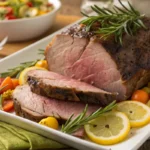
Easter Roast Beef: The Ultimate Guide for a Flavorful Easter Dinner
- Total Time: 1 hour 45 minutes
- Yield: 1 beef roast 1x
Description
Celebrate Easter with this show-stopping Easter Roast Beef—tender, juicy, and bursting with flavor. This classic centerpiece is seasoned with garlic, rosemary, and thyme, then slow-roasted to perfection.
Ingredients
- 1 (4 to 5 lb) beef roast (ribeye, sirloin tip, or top round)
- 4 cloves garlic, minced
- 2 tbsp fresh rosemary, chopped
- 1 tbsp fresh thyme leaves
- 2 tsp kosher salt
- 1 tsp black pepper
- 2 tbsp olive oil
- 1 tbsp Dijon mustard
- 1 onion, quartered
- 2 carrots, roughly chopped
- 2 celery stalks, roughly chopped
- 1 cup beef broth
- Optional: 1 tbsp Worcestershire sauce (for added depth in flavor)
Instructions
- Preheat your oven to 450°F (230°C).
- In a small bowl, mix the minced garlic, rosemary, thyme, salt, pepper, olive oil, and Dijon mustard to create a herb paste.
- Pat the beef roast dry with paper towels and rub the herb paste all over the meat.
- Arrange the chopped onion, carrots, and celery in the bottom of a roasting pan. Place the roast on top of the vegetables.
- Pour the beef broth (and Worcestershire sauce, if using) into the bottom of the pan to help keep the meat moist and create a flavorful base for gravy.
- Roast at 450°F for 15 minutes, then reduce the oven temperature to 325°F (165°C). Continue roasting for about 1 hour 15 minutes, or until a meat thermometer reads 135°F (57°C) for medium-rare.
- Remove the roast from the oven, tent it with foil, and let it rest for 15–20 minutes before slicing.
- Optional: Use the pan drippings and vegetables to make a rich gravy. Strain the juices and simmer with a bit of flour or cornstarch until thickened.
- Slice the roast beef thinly and serve with your favorite Easter sides.
Notes
- For a more deeply flavored roast, marinate it with the herb mixture overnight.
- Letting the meat rest is crucial for juicy slices—don’t skip it!
- Pair with mashed potatoes, roasted asparagus, or a spring salad for a full Easter spread.
- Leftovers make great sandwiches or beef and barley soup.
- Prep Time: 15 minutes
- Cook Time: 1 hour 30 minutes
- Cuisine: American
Nutrition
- Calories: 425 per serving
- Fat: 26g
- Carbohydrates: 4g
- Protein: 42g
